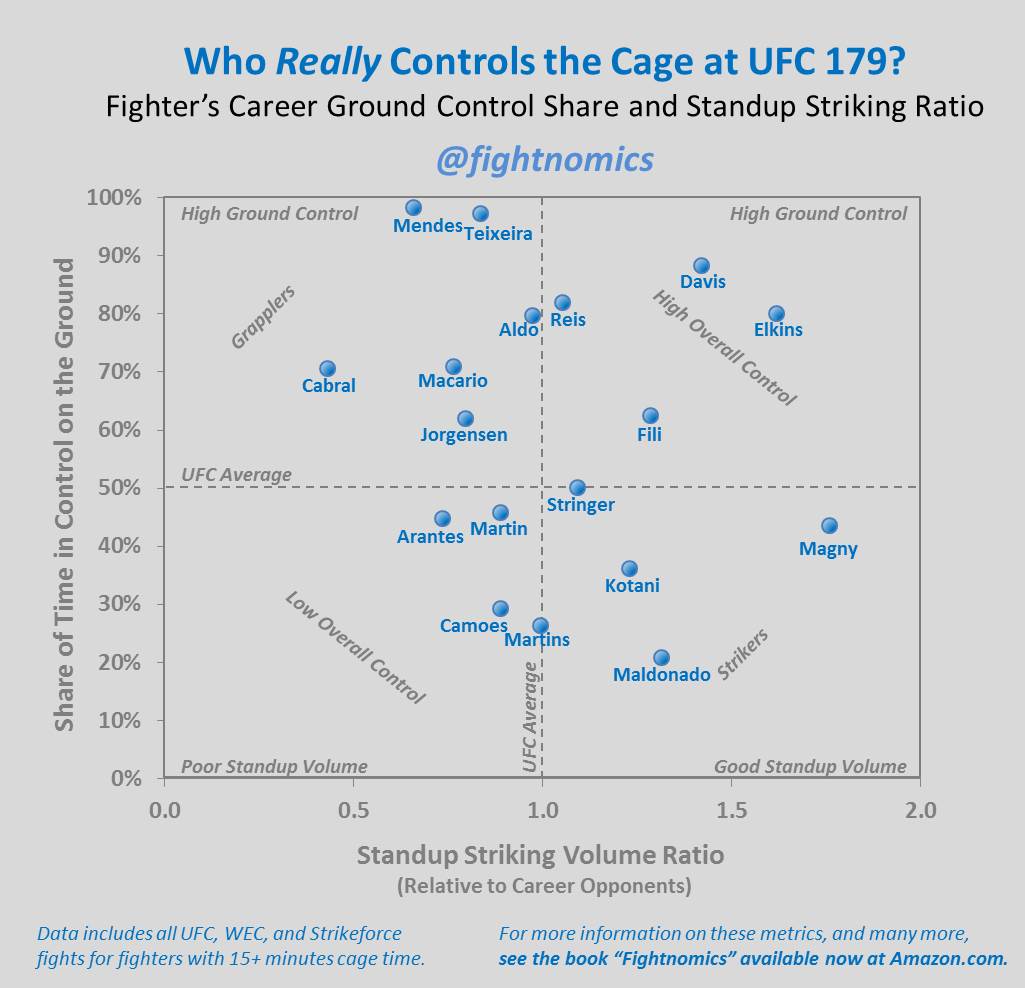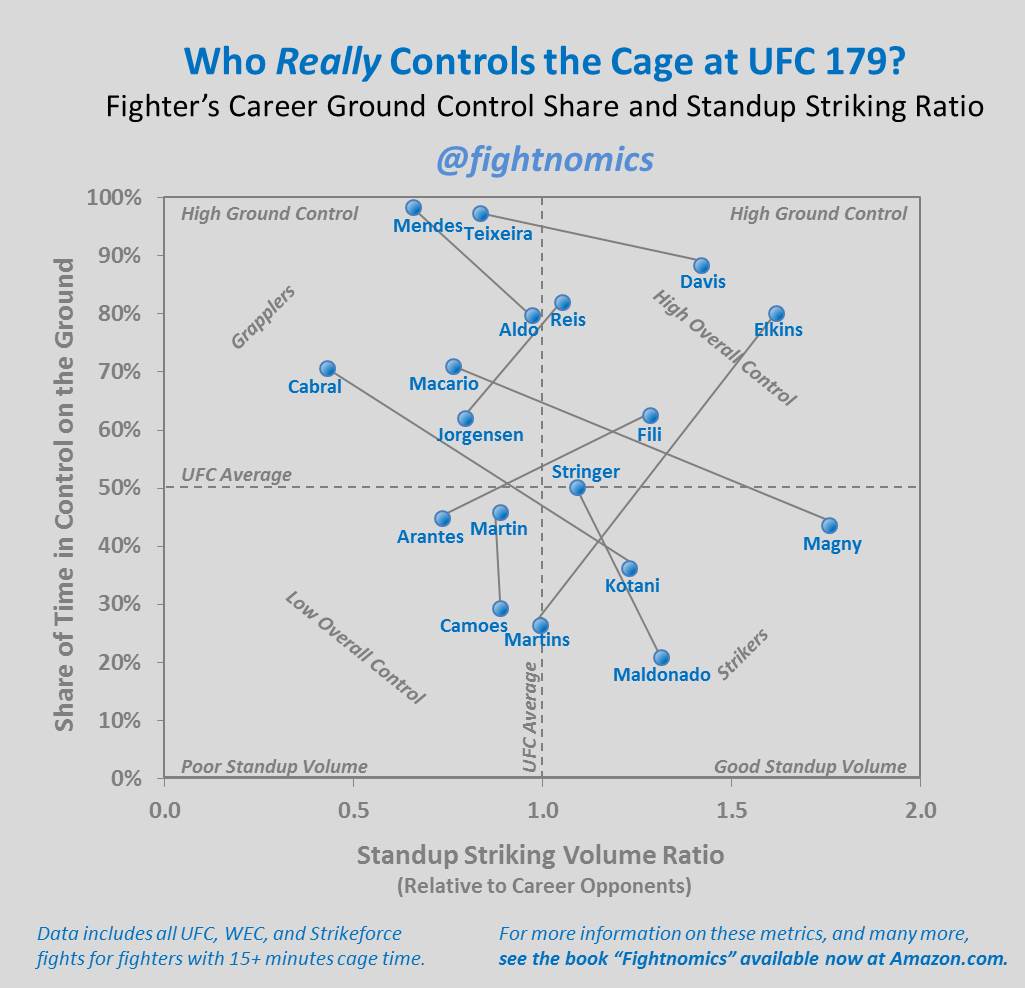By @fightnomics When it comes to winning rounds on the cards, fighters are ultimately trying to “impose their will” on their opponents. And that means controlling where and how the fight is fought. The idea of “Cage Control” is very loose. Most will grant cage control to the fighter moving forward more often on his feet, and to the fighter in top control more often on the mat. We know exactly the amount of time spent in control on the ground, which we covered for the UFC 179 fighters already. And although we don’t have motion-specific data on who moves where on their feet (yet), we do know how much strike volume a fighter throws during the course of his time spent standing and trading. The one who throws more strikes in a round that is mostly standing is normally the one winning that round. It’s not perfect, but it’s informative. So let’s tie the metrics for standup and ground control together in one graph, and just consider the fighters competing this weekend at UFC 179. Fighters come in all sorts of styles, and it’s interesting to see their underlying tendencies revealed in graphical form. The business students and consultants out there are likely familiar the concept of a “two-by-two matrix,” and the reality is that it can be deployed for a variety of data beyond business. By scattering the fighters this weekend across the plot of standup and ground control metrics, we can learn more about their fighting styles and capabilities, and maybe even something about their upcoming matchups.
The overall UFC average for Ground Control is 50%, and the UFC average Standup Volume Ratio is 1.0. For more on the nuances MMA statistics get the book “Fightnomics” at Amazon.
Leading the Pack: You may be surprised by some of the names in the leading (upper right) quadrant of the graph, as few of them are considered dominant fighters. But grinders will also fall into this bucket. None of these fighters has a losing record in the UFC so far, and collectively they are 18-6 in the UFC, with most of those fights coming from Davis and Elkins. Guys like Fili and Reis may fall out of this high control zone with more cage time, but they’re off to a solid start. Meanwhile, Phil Davis and Darren Elkins have something in common: they have dominating top games. When good wrestlers push forward and opponents fear the takedown, it allows the wrestlers to also win on volume on their feet, or at least nullify counter-strikers. Both these fighters are facing powerful strikers at UFC 179, so look for them to go for takedowns early and often. The Grapplers: The upper left quadrant include fighters that have high ground control, but lag their opponents while on their feet. These guys are generally better off on the ground, either thanks to their wrestling experience like Mendes and Jorgensen, or from long experience as a jiu jitsu player like Teixeira, Aldo, or Cabral. Macario may be the odd one out, as his background is primarily striking. He has lagged opponents on the feet (or been a counter-striker), but he has had success to date staying off his back. The Strikers: Several fighters this weekend will definitely be looking to keep the fight standing due to their experience in Muay Thai or boxing. That includes Maldonado and Martins, who have only 7 takedown attempts between them through over two hours of combined cage time! Then there’s Magny, one of the rangiest fighters in the UFC, whose long arms making bullying him in standup striking very difficult. Step it Up! A few guys haven’t been keeping up with opponents on the feet or on the mat in their UFC careers so far. That includes Camoes, Arantes, and Martin. These three guys are collectively 3-7-2 in the UFC to date, making the matchup between Camoes and Martin a likely “loser goes home” situation. Pairing Matchups: Now, what happens when we link up (for comparison) each pairing on the card? Here’s what the graph looks like now.
Fighting styles are all about tradeoffs and the pairings here have a lot of give and take, but the differences in the relative strengths of each fighter definitely come through. Only three fighter pairings have one fighter that is superior in both categories (the connecting lines go down and left). Darren Elkins wants to control the fight against the striker Lucas Martins – that much is obvious – but even while they’re standing Elkins could keep up a high enough pace to keep the score close before stealing rounds with a takedown. And Wilson Reis may be looking to stay ahead of Jorgensen on the feet, as well as on the mat. Although keep in mind much of Jorgensen’s cage time came from bouts at Bantamweight against larger opponents. Lastly, relative newcomer Andre Fili has control advantages with the help of his long reach for a Featherweight, but he won’t have a big reach advantage against Arantes. Fili will have to step up his game against the hometown fighter. Elsewhere on the card, Mendes has a better chance to win rounds on the mat, than purely in a striking exchange against Jose Aldo. And although Phil Davis is one of the biggest underdogs on the card, he has enough experience controlling fights on the mat and surviving dangerous strikers on the feet that he may be able to stifle and grind out the more dangerous Teixeira. I expect a decision in that matchup, and it could be closer than the betting public believes. “Fightnomics” the book is now available on Amazon! Follow along on Twitter for the latest UFC stats and MMA analysis, or on Facebook if you prefer.

